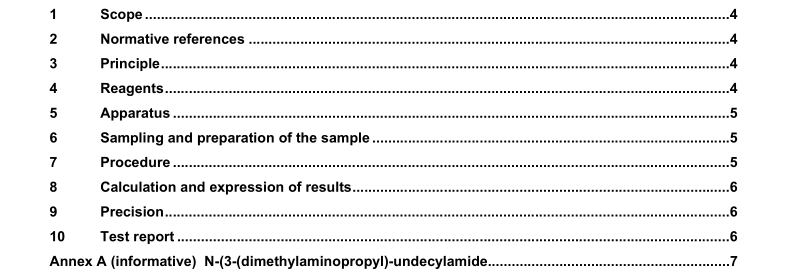EN 14881:2005 – Surface active agents – Determination of N-(3- dimethylaminopropyl)-alkylamide content in alkylamidopropylbetaines – Gas chromatographic method

1 Scope
This European Standard specifies a method for the determination of the content of free N-(3-dimethylaminopropyl)alkylamides (amidoamine) in alkylamidopropylbetaines, expressed in grams per 100 g of product.
This method is applicable in the range between 0,02 g and 1,0 g of amidoamine per 100 g of product.
2 Normative references
The following referenced documents are indispensable for the application of this European Standard. For dated references, only the edition cited applies. For undated references, the latest edition of the referenced document (including any amendments) applies.
EN ISO 3696, Water for analytical laboratory use – Specification and test methods (ISO 3696:1987)
ISO 607, Surface active agents and detergents – Methods of sample division
3 Principle
The method is based on the amidoamine extraction with diethyl ether at alkaline pH and subsequent analysis of the organic extract by GLC-FID. The chromatogram resolves the different amidoamines according to their alkyl chain length. The result is calculated from the sum of all the chain homologues.
4 Reagents
WARNING: Your attention is drawn to the regulations covering the handling of hazardous substances.
Technical organisational and personal protection measures should be observed.
During the analysis, unless otherwise specified, use only reagents of recognized analytical grade that have been checked in advance as not interfering with the analytical results.
4.1 Water, complying with grade 3 as defined in EN ISO 3696.
NOTE If the water is purified via ion-exchange resins, ensure that no cationic or anionic species from the resins cause interference.
4.2 Ethanol
4.3 Diethyl ether
4.4 N-(3-dimethylaminopropyl)-undecylamide (amidoamine-C11), purity ≥ 98 % m/m.
NOTE The N-(3-dimethylaminopropyl) alkylamide standard preparation and purity determination are given in Annex A.
4.5 Potassium hydroxide, ethanolic solution c (KOH)= 1 mol/l.
4.6 Internal standard solution
Weigh in a 50 ml volumetric flask, to the nearest 0,1 mg, approximately 0,2 g of the amidoamine-C11 (4.4).
Dissolve and make up to the mark with ethanol (4.2). Keep tightly closed.
4.7 Sodium chloride, aqueous solution, 30 % m/m.
4.8 Phenolphthalein, solution of 1 % m/V in ethanol.
5 Apparatus
Ordinary laboratory apparatus and the following.
5.1 Gas chromatograph, with capillary split injector, flame ionisation detector and integrator or computer.
5.2 Fused silica capillary column, coating with bonded deactivated poly (5 % diphenyl/95 % dimethyl) siloxane, length 30 m, internal diameter 0,25 mm, film thickness 0,50 µm (PTA-5 1) ).
5.3 Syringe, capacity 1 µl.
6 Sampling and preparation of the sample
The laboratory sample shall be prepared and stored in accordance with ISO 607.
7 Procedure
7.1 Calibration
Since it is assumed that the response factor of the different homologues is the same no extra calibration is needed (see Annex C).
7.2 Determination
Weigh to the nearest 0,1 mg, approximately 3,0 g of sample in a 15 ml vial with snap cap.
Add 2 ml of NaCl solution (4.7), and homogenise.
Add 1 ml of internal standard solution (4.6), measured with a one-mark pipette.
Add two drops of the phenolphthalein solution (4.8) and enough potassium hydroxide solution (4.5) to red change and add few extra drops of potassium hydroxide solution.
Add 4 ml of diethyl ether (4.3) measured with a measuring cylinder.
Stopper and shake the tube vigorously for about 1 min.
Let stand until the phases separate (usually 2 min will be enough).
Analyse the organic phase by injecting 1 µl of the organic layer directly into the gas chromatograph (5.1).
Set up the gas chromatograph to give results similar to the reference chromatogram in Figure B.1.
EN 14881:2005 – Surface active agents – Determination of N-(3- dimethylaminopropyl)-alkylamide content in alkylamidopropylbetaines – Gas chromatographic method